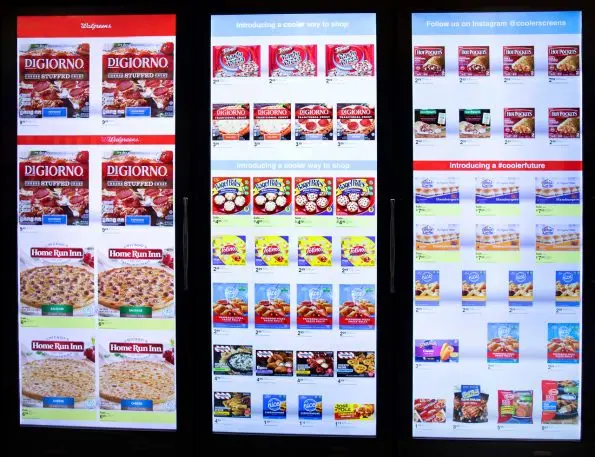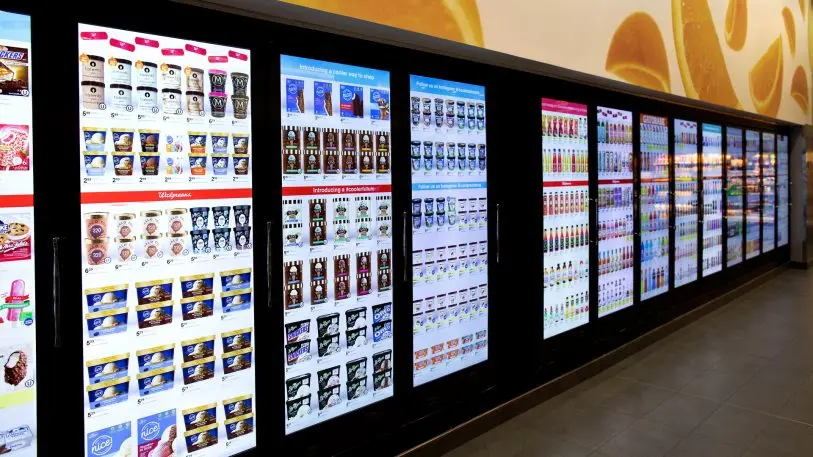I walk into a Walgreens just off Union Square in New York City that seems, on the surface, to be just like any other pharmacy. But as I make my way to the back of the store, where there are refrigerators and freezers that store cold drinks, ice cream, and other frozen food, the walls start to glow. That’s because the doors of most of these coolers are no longer the see-through glass you’d expect: Instead, they’re covered with screens that display what’s behind them using cheery, digital images and flashing promotions.
A man walks up to the screens, perplexed. “What the fuck is this?” he exclaims to an employee nearby, who is there to solicit feedback on the newfangled freezer doors. She explains briefly. “This is the future,” he says in awe.
[Image: Cooler Screens]
We live in a surveillance society, from the cameras that dot many street corners to the constantly tracking phones in our pockets. And soon, even the freezer door at your local convenience store will be tracking you too.
A startup named Cooler Screens is piloting a new door for commercial freezers and refrigerators that’s equipped with a camera, motion sensors, and eye tracking in six Walgreens pharmacies around the country, including the one off of Union Square. The doors can discern your gender, your general age range, what products you’re looking at, how long you’re standing there, and even what your emotional response is to a particular product.
The company says that the doors don’t store any of this data, which is anonymized, meaning that it won’t know that when you go to your local pharmacy you always buy ice cream (however, studies have shown that anonymized data, especially in cities, is possible to de-anonymize). Instead, it will use the data it’s collecting on you in real time to show you ads and promotions that the algorithm has determined might be relevant to you.
For instance, if a man is standing in front of a cooler where Coke is displaying ads, the cooler might show a Coke Zero ad since that particular product skews more male, while a woman might see a Diet Coke ad, according to Jamie Koval, the company’s chief design officer. Similarly, he says, if a twentysomething man was standing in front of the cooler, it might show him a Red Bull ad, whereas it might show Koval a Gatorade one, because of their different ages.
Similarly, the doors also use contextual information like the time of day to convince you to buy more. “You could pass by the beer door, and [the door] may notice that you’re picking up a six-pack of Miller Coors,” says Cooler Screens CEO and cofounder Arsen Avakian. “It’s 4 p.m., so it’s near dinner time. [It might] offer to you, buy a DiGiorno pizza for a special price if you’re buying a six-pack of Miller Coors.”

The company is also looking into ways that consumers might opt-in to sharing more detailed information with the system. For instance, one day you might be able to indicate in the Walgreens app that you like gluten-free products. Then when you walk by a set of Cooler Screens in a store, a screen could highlight the gluten-free options for you.
Through its real-time tracking, Cooler Screens is trying to bring the ad-targeting capabilities of the digital world to physical retail. And since the company’s research has shown that 75% of shoppers make decisions about what they’re going to buy from coolers on impulse, these ads have the potential to impact whether people are going to purchase Häagen-Dazs or Ben and Jerry’s–right when they’re about to reach for a pint.
That makes Cooler Screens valuable to companies that are fighting for customers’ attention on the freezer shelf; so far, the startup has booked advertising deals with more than 15 of the 20 top consumer packaged goods companies, including Coca-Cola, Pepsi, Nestle, MillerCoors, and Anheuser Busch. Even if a company doesn’t choose to advertise with Cooler Screens, their products within the cooler will still be represented on the screen with a life-size image, but the advertisers can buy things like banner ads, full-size ads that can take over one full screen or multiple screens, and real-time promotions.
These advertising deals are the lifeblood of Cooler Screens, which doesn’t require pharmacies to buy the doors at all. Instead, Cooler Screens retrofits the doors of traditional coolers with its digital ones for free, and then sells the advertising on those screens. Avakian says that in the first two months of its initial pilot, products that were advertised on Cooler Screens had more than 20% year-over-year growth in sales compared to other products.
This isn’t just a good gig for the companies trying to convince you to buy their beer. Cooler Screens says it’s also benefiting the Walgreens where it was first piloted in Chicago, which has seen double-digit, same-store sales growth for the Cooler Screens section as compared to the rest of the pharmacy.
The idea for Cooler Screens came directly from the experience of Avakian, who previously started and ran the indie beverage brand Argo Tea. “I’ve spent hours standing in front of [cooler] doors, observing consumers and their behaviors, and witnessing all the challenges there for . . . a smaller brand [surviving] against larger companies like the Cokes and Pepsis,” he says. “But every time Argo would have the opportunity to have a little message or sticker, a tag saying that Argo is organic and non-GMO, we would see a significant increase in sales.”
Plus, coolers are generally a mess, with products in the wrong places and prices or promotions not clearly visible–if they’re there at all. Avakian saw an opportunity to provide a better shopping experience for consumers, targeted advertising for brands anxious to stand out, and better product tracking for grocery and convenience stores, which currently lack an easy way to tell if a cooler is out of stock. He teamed up with Greg Wasson, the former president and CEO of Walgreens, and launched in November 2017. Its investors include Microsoft (all of Cooler Screens’ technology is built on top of the Microsoft cloud), Verizon, and Dover, one of the country’s largest door manufacturers.

As for consumers, Cooler Screens claims that its flashy screens provide a better shopping experience. But Koval, the head of design, was personally worried during the design process that people wouldn’t realize they were doors. So he deliberately designed the interface so that it corresponds exactly to what’s on the shelf behind the screen, with subtle details, like having the price tags hang down below each product, that would mimic the freezers people were used to. “The reason we went that route was we wanted to help consumers understand the world they were in and not go so far away from that so that [the interface] seemed like an operating system or looked too much like the way you see your apps on an iPhone,” he says.
Still, it’s hard not to see the screens as freezer doors as giant iPads (the doors do have touch-screen capacity, but Koval says it hasn’t been enabled yet). One woman standing near me at the Union Square Walgreens remarked that she was frustrated when she touched the screen and nothing happened. The experience wasn’t as seamless as promised, either. One of the screens was malfunctioning, causing a constant flicker that ruined the illusion of the long digital shelves. In the ice cream freezer, a whole shelf was mislabeled, with half the items the door promised missing.
As I strolled around the back of the Walgreens, the screens informed me which drinks were zero calorie and which had a discount with a store card. I learned that Ben & Jerry’s Salted Caramel Core is non-GMO, while its Phish Food is kosher. Banner ads for Smart Water flashed as I walked by.
Was I seeing a Smart Water ad because I’m a woman? It’s not clear.
That’s a problematic lack of transparency. There’s no disclosure that users are being watched and their behavior analyzed. When I was looking at the doors, I couldn’t find any sign of the cameras at all, although I knew they were watching me. When I asked Koval about how he designed the doors so that people wouldn’t find it creepy, he pointed again to the fact that the data is anonymized as enough reason for consumers to accept the technology. But these are serious privacy considerations as retail stores bring some of the tracking that already occurs online into the real world. Most of us are aware that Facebook is tracking what we “like” on its website, but few would expect to have their emotions monitored at the local pharmacy.
Ultimately, for consumers who don’t want to be targeted, the only way to opt out is to avoid stores that do it. But as more and more brick-and-mortar stores install similar technology, it will be increasingly difficult to avoid.
Recognize your brand’s excellence by applying to this year’s Brands That Matter Awards before the early-rate deadline, May 3.